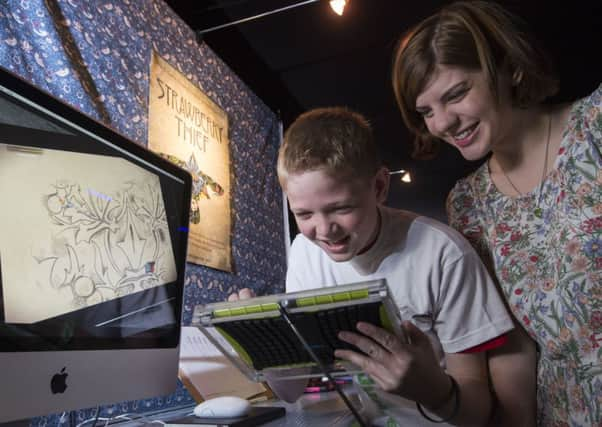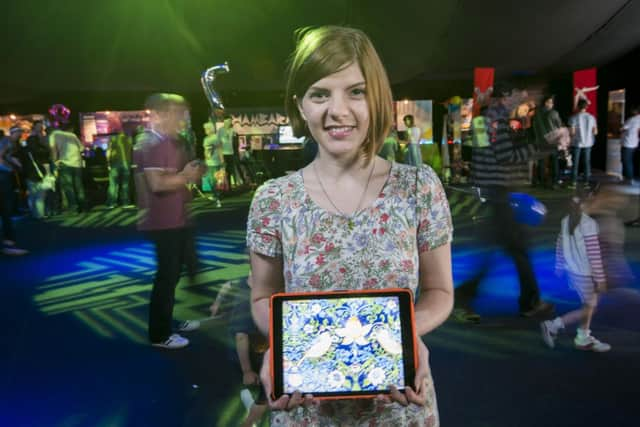The artist combining video games and Victorian art


What do the Victorian arts and crafts designer William Morris and computer gaming have in common?
The answer is Sophia George, a games designer working at Abertay University in Dundee and the first games designer in residence at the V&A. The 24-year-old has taken Morris’s textile print Strawberry Thief and ripped it off the walls and sofas of the nation’s sitting rooms and released it into the virtual world in the form of a free iPad game.
Advertisement
Hide AdAdvertisement
Hide AdReleased next month, the game sees players guiding a thieving thrush around a sketch of Morris’ iconic 1883 pattern that was inspired by a bird stealing fruit in his garden.


Players colour it in, build it up and bring it alive to the strains of a soaring soundtrack specially commissioned from the Royal Scottish National Orchestra.
George’s residency is a partnership project between V&A, V&A Dundee and Abertay University, where the game was developed. Her career as a gamer began with a post-graduate course, Professional Masters in Games Development at Abertay in Dundee. She won the University’s Dare to be Digital competition in 2011 with fellow Abertay post graduate Kristian Francis with a game that went on to win a BAFTA Ones to Watch award the following year. When the V&A decided that a design museum really should be embracing the virtual world they headed to Abertay, recognised worldwide as being at the forefront of teaching computer gaming technology.
“The V&A came to us because we’re the longest established university in the world teaching in this area and they’re really interested in Scotland’s heritage in games and what it means for them as a museum,” says Chris Wilson, Abertay communications manager.
Strawberry Thief was made in the university’s Game Lab by George and a team including Ellen Brown creating the 2D artwork, Cameron Moore working on the animation, Erin Michno programming and Neil Cullen, who works at the Royal Scottish National Orchestra, composing the music. “They all did a fantastic job,” says George.
“The aim of the game is to create something instead of destroying something,” she adds. “In a lot of games, even very safe ones like Candy Crush, the idea is to get rid of things, get obstacles out of the way or kill people, so it’s interesting to turn that on its head.”
George has an all-embracing attitude to games herself. A self-confessed computer “geek”, she loves them all, from shoot-em ups and sandbox styles, like Grand Theft Auto and Red Dead Redemption, to elegant architectural puzzles like Monument Valley and the digital lego of Minecraft, but she thinks there’s room for expansion.
“Action-packed is great, but there’s space for games that make you think about the world; games with political and historical themes, games that explore art and design. There are people who like big blockbuster games like Assassin’s Creed and Call of Duty, others who only really like independently-developed ones, and people like me who enjoy all types. There are some that take 200 hours to play, then there’s Strawberry Thief, which is five or ten minutes of fun. There’s room for them all,” she says.
Advertisement
Hide AdAdvertisement
Hide AdFeedback so far has been enthusiastic. At the Dare Protoplay Festival at Abertay University last month, when the prototype was unveiled, George saw families spanning the generations playing her game. The festival attracts gamers and the digitally curious of all shapes and sizes, and sees hundreds of entries for its Dare to be Digital game design competition.
“I was relieved they liked it. It’s for schoolchildren, parents, teachers, people that are interested in art and culture and curious about digital games, and also for people that are already into games that it might be a new experience for,” she says.
“Computer games are an unbelievably creative medium, and one that is often overlooked. With this V&A residency I’m hoping that anyone with a love of art, design or music will start to appreciate the beauty and joy digital technology can create,” says George. “I wanted to show people that games can be made about anything.”
George spent six months at the V&A in London doing research among its thousands of artefacts from 3,000 years of culture.
“I looked through the whole of the British Gallery at the V&A. There’s so much in there I could make hundreds of games but the Strawberry Thief pattern is such a strong, popular design, it’s on everything from cups to Dr Marten boots. And it already had some game elements in it – the bird would be the main character, the strawberries and the flowers the power up, the background, the environment. You can turn a bit of art into a game, open up people’s minds. It’s a strong design and I wanted to make a game that’s very busy-looking. There are lots of games with minimalist graphics but I wanted ‘in your face’.”
After working with schools through V&A education workshops George is keen to do more and get girls in particular to follow her route into gaming.
“The games industry is very male-dominated for many reasons, partly how we bring up girls, but people are becoming more sensitive and the number of women in games is rising. It’s under 20 per cent at the moment but hopefully in the future it’ll get to 50:50. In a lot of the big popular games the women characters don’t talk, have to be saved by the hero and are sexualised, but the new Lara Croft game last year with the script by Rhianna Pratchett was a step in the right direction. I’m a woman working in the games industry and the game I’ve made is quite different. What would a game made by a jewellery designer or woman artist be like?” she says.
George’s gaming career began playing games at home in East Anglia where she and her two siblings were encouraged by their parents to explore new technologies.
Advertisement
Hide AdAdvertisement
Hide Ad“I can’t remember not thinking that I wanted to work in games but when I was at school I never met a game designer. I just played them all the time. But I was always arty, always drawing too. There are so many career options in the games industry – audio, art, motion capture, voice action. People are told you have to be good at maths to do games, but it’s not true. Some games are more like making a Hollywood movie. Children can make their own games, there are programmes for that and it would be nice if game design became more like other art, something families and children do together.”
Despite being headhunted by the gaming industry and inundated with job offers, George is happy to continue doing her own thing.
“A lot of people are interested in employing me but I’m not really ready for that kind of thing. I want to make more games like Strawberry Thief and experiment with game play in art. I have had so many opportunities from the V&A residency, I want to keep the creative control,” she says.
Future projects include possibly creating games exploring other artists’ work, such as textile designer CFA Voysey and Charles Rennie Mackintosh, or some of the Romantic oil paintings.
“I don’t think anyone else has done a William Morris game,” says George. “I wonder what he’d make of it. He was a creative, who liked to embrace new things, so…”
Since Morris once wrote, “The past is not dead, it is living in us, and will be alive in the future which we are now helping to make,” we can assume, if he was alive today, he’d be reaching for his iPad to play Strawberry Thief.
• Strawberry Thief for iPad will be released next month, http://store.apple.com/uk; www.sophiageorge.com; www.abertay.ac.uk